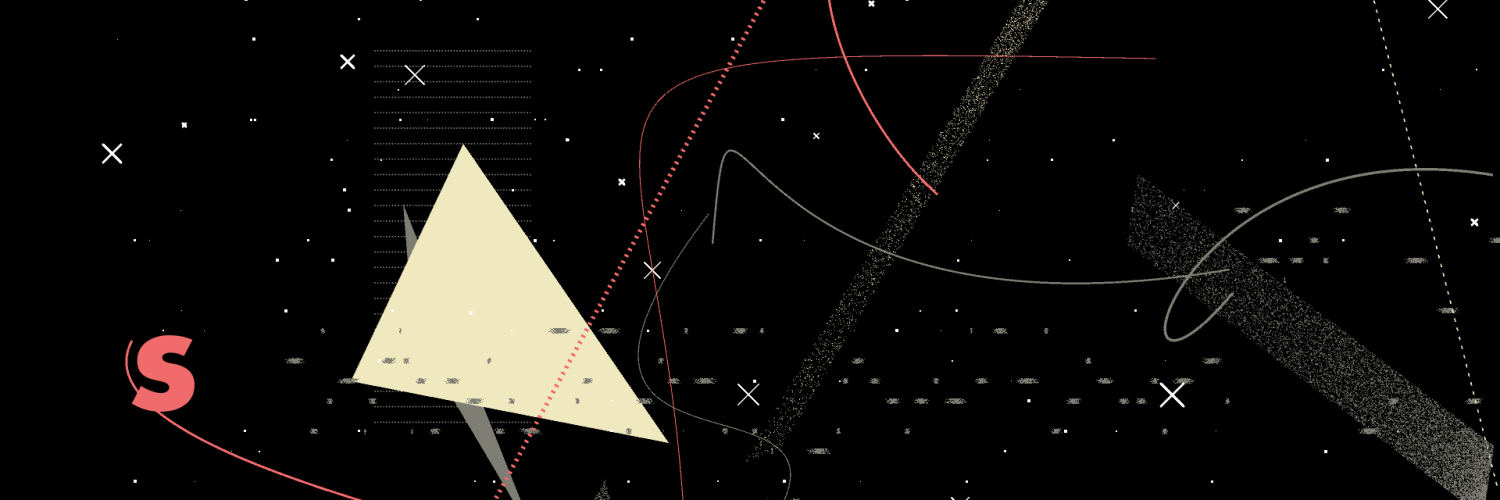
Forms, by Santi Vilanova. Credit: Santi Vilanova
ARS ELECTRONICA BARCELONA GARDEN SHOW
Dates: From 9.9.2020 to 20.9.2020
Time: Tuesday to Saturday: 11 to 2 p.m. / 4 to 8 p.m. Sundays and holidays: 11 to 2 p.m. / 3 to 7 p.m. CEST
Location: Arts Santa Mònica. La Rambla, 7. Barcelona, Spain.
Entrance: Free entrance. No prior registration required.
Three new works will also be exhibited, produced thanks to some grants given to Monica Rikić for New Home of Mind, Roc Parés for Doble consciència and Santi Vilanova for Forms – Screen Ensemble. The three projects have been selected through a public call for production and exhibition of the Institut Ramon Llull, NewArtFoundation and Hangar, in collaboration with the BEEP Collection.
The exhibition offers a representative example of the activity of the BEEP Collection, a Catalan collection with an international vocation, which is not only dedicated to attracting works, but also to the production of projects by emerging and consolidated artists and to the recovery, restoration and conservation of pioneering works, essential for the construction of the history of electronic art.
The exhibition at the Garden Barcelona will be open to the public on the days of the festival and will continue until 20 September, when it will participate in the special edition of Sónar + D CCCB, which will be held at the Centre de Cultura Contemporània de Barcelona on 18 and 19 September.
WORKS
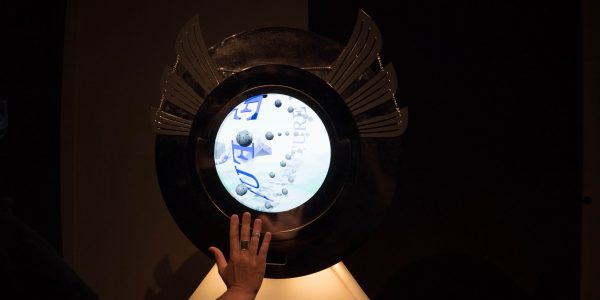
New Home of Mind. Mónica Rikić. 2020
Futuristic fiction art installation that deals with the perception of identity in intelligent artificial entities, and embraces the possibility of a genuine artificial spirituality. It starts from the idea of a conscious robot with an existential crisis after having his life purpose removed from its code. Now, it searches for the meaning of his existence through an artificial spiritual interface. This project represents that interface as a divine robot, while researching on artificial spirituality and revealing reflections and thoughts between cyberpunk, technoethics and technohumanism.
What happens with our self perception and emotional development in a world ruled by an automaton god?
Mónica Rikić (ES)
New media artist and creative coder from Barcelona. She uses code, electronics and analog objects to create interactive works framed as experimental games. Her interest lies in the social impact of technology, human-machine coexistence and the reappropriation of technological systems and devices, to manipulate and rethink them through art. From educational approaches to sociological experimentation, her works propose new ways of thinking and interacting with the digital environment that surrounds us. She has participated festivals such as Japan Media Arts Festival, FILE Festival, A MAZE, Sónar and in previous editions of Ars Electronica, among others.
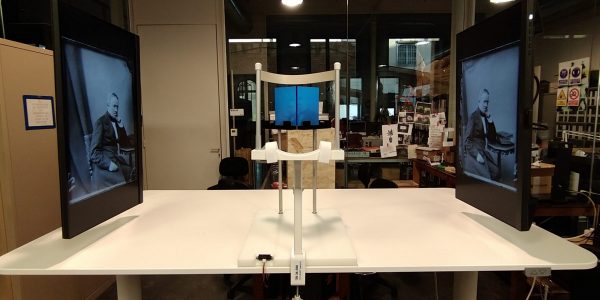
Doble consciència. Roc Parés Burguès. 2020
Doble Consciència is an interactive audiovisual installation, inspired by the stereoscope, invented by Sir Charles Wheatstone, during the first third of the 19th century. Paradoxically, while Wheatstone studied how binocular vision allows us to perceive two different images as a single “solid” object, Parés’s intention is to experiment with binocular rivalry as a way of deconstructing and questioning individual subjectivity: hacking into vision to hack into consciousness. Currently, stereoscopy is used in cartography, surgery, astronomy, microscopy and virtual reality, but the pairs of discrepant images, seen through conventional devices, always construct a unitary vision. According to his proposal, the discrepant vision of our two eyes can become the gateway to a splitting of conscious attention.
Technically, the installation is a Digital Haploscope. The images are presented on two side monitors, which are looked at through the two mirrors located in the center of the elevating table, in front of the eyes. Initially the pairs of images presented to the visitor form stereoscopic pairs that present three-dimensional images. Progressively, variations are introduced in the pairs of images, accentuating the difference between them, taking the discrepancy to the limit of binocular rivalry. Finally, the experience ends with pairs of images made expressly in order to overcome the binocular rivalry and to propitiate the hypothetical emergence of the Double Consciousness of each participant.
Roc Parés Burguès (MX)
Research artist in interactive communication. Doctor in Audiovisual Communication (UPF, 2001), Bachelor of Fine Arts (UB, 1992). Professor at Pompeu Fabra University and Member of the National System of Art Creators of Mexico. His artistic works have been presented in museums, art centers and festivals in Europe, America and Asia. He has published with British Computer Society, Academic Press, MIT Press, among others. Committed to an interdisciplinary culture, which he defends for its emancipatory potential, Parés has spent thirty years exploring the intersections between art, science, technology, thought and society.
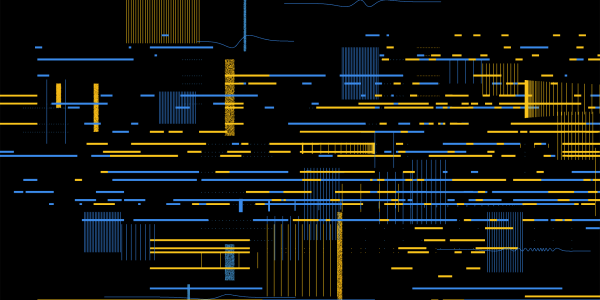
Forms. Santi Vilanova. 2020
FORMS is a generative visual music bot.
Driven by a set of rules based on randomness and probability, it can generate and endless number of graphic scores. This scores are automatically sonified thanks to spectral sound synthesis algorithms, bluring the boundaries between scores and spectrums.
The resulting graphics can be framed within the tradition of graphic notation that gained strength among twentieth-century composers (John Cage, Iannis Xenakis, Karlheinz Stockhausen, Morton Feldman, Mestres Quadreny…), and which allowed music to be released from the rigidity of classic staves.
FORMS has been “dreaming” without interruption for more than 5000 hours and streaming this visual music dreams online: https://www.twitch.tv/playmodes.
After a well deserved break, and for the Ars Electronica exhibition, FORMS is materialized as a “Screen Ensemble”. A triptych of large format screens interpret one instrument each: Rhythm, Harmony or Texture. Thanks to its networked brain, this 3 instruments are coordinated between them, each one playing a part of a real-time generative composition which will never be repeated again.
Santi Vilanova (ES)
Graduate in graphic design and passionate about sound art, Santi Vilanova has been able to combine these two disciplines through the catalyst of “creative technologies”, of which he is a self-taught developer.
(de)Formed at the rave scene of the early 2000, his sound work has been evolving to integrate this underground influence into new territories. His recent research blend together digital algorithms or sonification engines with classic staves and acoustic ensembles, focusing on the idea of a visual music.
He is founder, with Eloi Maduell, of the Playmodes audiovisual research studio, where they develop projects at the edge of design, art and science. Interests related to acoustics, mathematics, perception psycology or light phenomena crystallize at the shelter of Playmodes. Their projects, eclectic in nature -from opera scenography to immersive installations- always have as a common element a creative use of digital tools and the search for a unified audio+visual language.
As part of this collective, his works have been exhibited at light festivals (Fête des Lumieres, Signal, LlumBCN, Mapping Festival, LIT Bogotá, Chartres a Lumière …), at electronic music events ( Sónar, Mira, LEV, DGTL, D4N Houston …), at contemporary art or performing arts institutions (ZKM, Macau Arts Festival, In Between Time, Copenhagen Opera), and has been awarded with international distinctions in the field of new media (Ars Electronica Honorary Mention, LAUS, Visual Music Awards or LAMP awards).
He is also currently a university professor at the EINA school (Universitat Autònoma de Barcelona), UOC and BAU (Universitat de Vic), teaching new generations of multimedia creators.
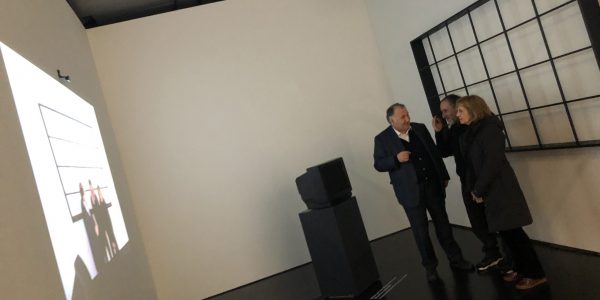
Das Tangible Bild. Peter Weibel. 1991 / 2019
In the interactive computer installation Das tangible Bild [The Tangible Image], you are standing in front of a Cartesian coordinate grid. You are filmed standing in front of this grid by a camera, you see the image projected on the opposite wall. When you touch the rubber screen of the monitor, which stands on a pedestal in the middle of the room, the projected image warps. Thus, you can interact with the image via a three-dimensional “touch screen” in real time. Each time you touch the screen, behind which sensors are installed, information is sent to a computer to which the camera’s live images are transferred. In the computer, the signals of the warping of the screen converted into digital data influence the data representing your image within the space. The screen and the Cartesian grid become identical. Real distortions of the rubber screen appear in the projection image as distortions of the grid in front of you. An interface (the rubber screen) is switched on between the grid and the projection image. It is not the changes in the grid that affect the projection, but the changes in the interface. Is our world merely the product of an interface technology, the interface of the natural body?
Credits
Artists: Peter Weibel
Interface / software: Bob O’Kane
Acknowledgements: Anita Beckers
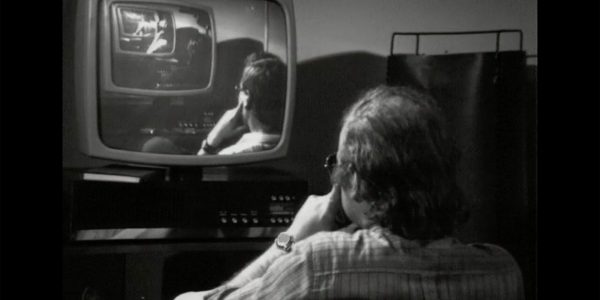
The Endless Sandwich. Peter Weibel. 1972
Between the TV set and viewer, a function exists whereby the user switches on and off the appliance. He has reproduced this function and made it the content of the TV programme. Sandwich character of real process and reproduction process, of reflection and action. On the screen, a series of viewers is seen sitting in front of TV sets. A fault occurs in the last set shown, meaning the next viewer has to get up in order to repair the fault. This repair brings about a disruption in the next viewer’s screen. The disruption propagates itself until it reaches the real TV set, meaning the real viewer has to rise and eliminate the fault. Time delay: the real procedure is the conclusion of the reproduced procedure.
Credits
Artists: Peter Weibel
Acknowledgements: Anita Beckers
Peter Weibel (AT)
Peter Weibel (Odessa, 1944) is an emerging artist. He studied literature, medicine, logic, philosophy, and film in Paris and Vienna. He became a central figure in European media art on account of his various activities as artist, media theorist, curator, and as a nomad between art and science.
From 1984 until 2017, he has been a professor at the University of Applied Arts Vienna. From 1984 to 1989, he was head of the digital arts laboratory at the Media Department of New York University in Buffalo, and in 1989 he founded the Institute of New Media at the Städelschule in Frankfurt on the Main, which he directed until 1995. Between 1986 and 1995, he was in charge of the Ars Electronica in Linz as artistic director. From 1993 to 2011 he was chief curator of the Neue Galerie Graz and from 1993 to 1999 he commissioned the Austrian pavilion at the Venice Biennale. He was artistic director of the Seville Biennial (BIACS3) in 2008 and of the 4th Moscow Biennial of Contemporary Art, in 2011. From 2015–2017, he was curator of the lichtsicht 5 + 6 – Projection Biennale in Bad Rothenfelde.
Peter Weibel was granted honorary doctorates by the University of Art and Design Helsinki, in 2007 and by the University of Pécs, Hungary, in 2013. In 2008, he was awarded with the French distinction »Officier dans l’Ordre des Arts et des Lettres«. The following year he was appointed as full member of the Bavarian Academy of Fine Arts Munich, and he was awarded the Europäischer Kultur-Projektpreis [European Cultural Project Award] of the European Foundation for Culture. In 2010, he was decorated with the Austrian Cross of Honor for Science and Art, First Class. In 2013 he was appointed an Active Member of the European Academy of Science and Arts in Salzburg. In 2014, he received the Oskar-Kokoschka-Preis [Oskar-Kokoschka-Prize] and in 2017 the Österreichische Kunstpreis – Medienkunst [Austrian Art Prize – Media Art]. In 2015 he was appointed as Honorary Member of the Russian Academy of Arts in Moscow.
Since 1999, Peter Weibel is Chairman and CEO of the ZKM | Center for Art and Media Karlsruhe and since 2017 director of the Peter Weibel Research Institute for digital Cultures at the University of Applied Arts Vienna.
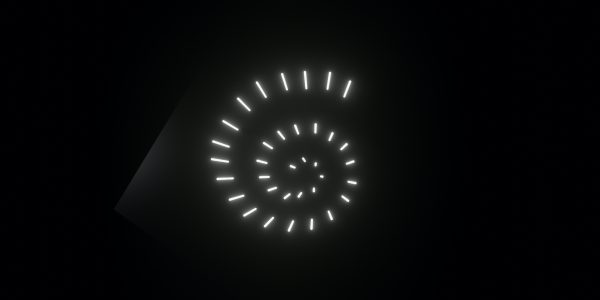
VESTIBULAR_1. Albert Barqué-Duran i Marc Marzenit
VESTIBULAR_1 is an immersive audio-visual installation that invites the audience to wander inside a vestibular system structure. In specific, the installation induces illusory sensations of self-motion by temporarily disrupting the audience’s vestibular functioning via specific patterns and configurations of audio and light stimuli.
Any organism moving through its environment receives a constant stream of sensory signals about self-motion: optic flow inputs from vision, proprioceptive information about the position of the body from muscles, joints and tendons, and inputs for acceleration via the vestibular system. This latter seems particularly important for self-motion (Green & Angelaki, 2010).
Under normal circumstances, the brain optimally combines sensory signals for self-motion, which are successfully integrated to produce a coherent representation of the organism in the external environment. However, conflicts between sensory modalities may occur when sensory signals carry discrepant information. If the vestibular system is altered with conflicting sensory information, we easily realise that the usual way in which we perceive objects of human expression, such as visual forms, music, and art, does dramatically change (Gallagher, M., Dowsett, R., & Ferrè, E.R., 2019).
The installation VESTIBULAR_1 is based on the innovative research from the VeME (Vestibular Multisensory Embodiment) Lab at Royal Holloway, University of London, which investigates the role played by vestibular signals in the perception and representation of the body and the external world and how it affects aesthetic preferences.
Credits
Artists: Albert Barqué-Duran; Marc Marzenit
Co-Producer: .BEEP { collection;} – NewArtFoundation
Technology Partner: Protopixel
Technology Suppliers: Sfëar – Eurecat, Silentsystem
In collaboration with: Elisa Ferrè (Vestibular Multisensory Lab – Royal Holloway, University of London)
Acknowledgements: LaAgencia
Albert Barqué-Duran (ES)
Albert Barqué-Duran, PhD, is an artist and researcher. Lecturer in Creative Technologies and Digital Art at University of Lleida and Honorary Research Fellow at City, University of London. Albert earned his PhD and Postdoc in Cognitive Science from City, University of London and has been a Visiting Postgraduate Researcher at Harvard University and University of Oxford. His artwork and performances are inspired by his research and combine new media art techniques (A.I., computational creativity, data, experimental electronic music) and classical fine art methods (oil painting, sculpture) to reflect on universal topics (knowledge, digital culture, futures). He leads disruptive projects at the intersection of art, science and technology with the aims of: (1) finding novel formats of generating artistic and scientific knowledge; (2) reflecting about contemporary and futuristic issues and its cultural implications; (3) creating powerful experiences to push the boundaries of human perception. Considered 1 of the 64 “Culture Activists” in Europe during 2019 by We Are Europe, and internationally awarded by the “Re:Humanism Prize”, the “We Are Equals – MUTEK Music Academy”, the “Art of Neuroscience Award”, and the “International Award City of Lleida”, Albert has exhibited and performed at Sónar+D (Barcelona, Spain), Ars Electronica (Linz, Austria), ZKM (Karlsruhe, Germany), Creative Reactions (London, UK), Cricoteka (Krakow, Poland), Albumarte (Rome, Italy), SciArt Center (New York, USA), IGNITE Fest (Medellín, Colombia), Mobile World Congress (Barcelona, Spain) or Ming Contemporary Art Museum (Shanghai, China).
Marc Marzenit (ES)
Marc Marzenit is an audio engineer, composer, music producer and Dj with many years of experience touring the world. He performed in places like London, Paris, New York, Los Angeles, Argentina, Mexico, Australia, Canada or Asia, just to name a few. Besides his profile as underground musician, he also created shows like “Suite on Clouds”, a 3D mapping show with 8 violinists, 1 harp, symphonic percussion, synthesizers and a grand piano. These projects draw on his classical background and show his integrated vision of electronic music: combining acoustic, analogue and digital instruments together in the same show. He is currently a Lecturer in “Music and Sound for Interactive Experiences” at ENTI- Universitat de Barcelona; and the Founder of Aulart.